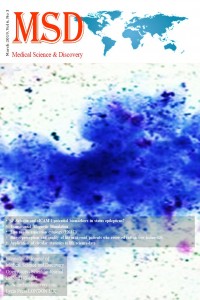Öz
Kaynakça
- 1. Lai MK.. Some Results on the Statistical Analysis of Directional Data. Master thesis, University of Hong Kong, Hong Kong Pokfulam, 1994.
- 2. Mardia KV, Jupp PE. Directional Statistics. John Willey and Sons. Inc., Chichester. 2000.
- 3. Jammalamadaka SR, SenGupta A. Topics in Circular Statistics. London: World Scientific; 2001. p.322.
- 4. Mahan RP. Circular Statistical Methods: Applications in Spatial and Temporal Performance Analysis. DTIC-ADA240751, Virginia, 53s. 1991.
- 5. Hintze JL. 2007. Circular Data Analysis. ss 927-955. Hintze, J.L. NCSS Help System, Published by NCSS, Utah 2823s. 2007.
- 6. Hussin AG, Jalaluddin JF, Mohamed İ. Analysis of Malaysian Wind Direction Data Using AXIS. Journal of Applied Science Research, 2006, 2(11): 1019-1021.
- 7. Ser G. Directional Data Analysis and An Application. Yüzüncü Yıl Üniversitesi Tarım Bilimleri Dergisi; Yıl: 2014 Cilt: 24 Sayı: 2; 121-126. 2014.
- 8. Berens P. CircSat: A MATLAB Toolbox for Circular Statistics. Journal of Statistical Software, 2009, 31: 1-21..
- 9. Fisher NI. Statistical Analysis of Circular Data. Cambridge University Press, New York, 277s. 1993.
- 10. Mardia KV. Statistics of Directional Data. Academic Press. Inc., London, 357s. 1972.
- 11. Brunsdon C, Corcoran J. Using circular statistics to analyse time patterns in crime incidence. Computers, Environment and Urban Systems, 2006, 30: 300-319..
- 12. Gaile GL, Burt JE. Directional Statistics. Concepts and Techniques in Modern Geography, London, 39s. 1980.
- 13. Peker KÖ, Bacanlı S. Descriptive Statistical Methods Applied to Circular Data and A Meteorological Application. Anadolu University Journal of Science and Technology, 2004, 5: 115-122.
- 14. Zar JH. Biostatistical Analysis. Prentice Hall, New Jersey, 944s. 2010.
- 15. Wheeler S, Watson GS. A distribution-free two-sample test on a circle. Biometrika, 1964,.51: 256-257.
Öz
Objective: Material and Methods: The data related to 179 normal deliveries that took place in Results: The Conclusion: It |
Anahtar Kelimeler
Circular data analysis circular statistics statistics Von Mises
Kaynakça
- 1. Lai MK.. Some Results on the Statistical Analysis of Directional Data. Master thesis, University of Hong Kong, Hong Kong Pokfulam, 1994.
- 2. Mardia KV, Jupp PE. Directional Statistics. John Willey and Sons. Inc., Chichester. 2000.
- 3. Jammalamadaka SR, SenGupta A. Topics in Circular Statistics. London: World Scientific; 2001. p.322.
- 4. Mahan RP. Circular Statistical Methods: Applications in Spatial and Temporal Performance Analysis. DTIC-ADA240751, Virginia, 53s. 1991.
- 5. Hintze JL. 2007. Circular Data Analysis. ss 927-955. Hintze, J.L. NCSS Help System, Published by NCSS, Utah 2823s. 2007.
- 6. Hussin AG, Jalaluddin JF, Mohamed İ. Analysis of Malaysian Wind Direction Data Using AXIS. Journal of Applied Science Research, 2006, 2(11): 1019-1021.
- 7. Ser G. Directional Data Analysis and An Application. Yüzüncü Yıl Üniversitesi Tarım Bilimleri Dergisi; Yıl: 2014 Cilt: 24 Sayı: 2; 121-126. 2014.
- 8. Berens P. CircSat: A MATLAB Toolbox for Circular Statistics. Journal of Statistical Software, 2009, 31: 1-21..
- 9. Fisher NI. Statistical Analysis of Circular Data. Cambridge University Press, New York, 277s. 1993.
- 10. Mardia KV. Statistics of Directional Data. Academic Press. Inc., London, 357s. 1972.
- 11. Brunsdon C, Corcoran J. Using circular statistics to analyse time patterns in crime incidence. Computers, Environment and Urban Systems, 2006, 30: 300-319..
- 12. Gaile GL, Burt JE. Directional Statistics. Concepts and Techniques in Modern Geography, London, 39s. 1980.
- 13. Peker KÖ, Bacanlı S. Descriptive Statistical Methods Applied to Circular Data and A Meteorological Application. Anadolu University Journal of Science and Technology, 2004, 5: 115-122.
- 14. Zar JH. Biostatistical Analysis. Prentice Hall, New Jersey, 944s. 2010.
- 15. Wheeler S, Watson GS. A distribution-free two-sample test on a circle. Biometrika, 1964,.51: 256-257.
Ayrıntılar
| Birincil Dil | İngilizce |
|---|---|
| Konular | Sağlık Kurumları Yönetimi |
| Bölüm | Araştırma Makalesi |
| Yazarlar | |
| Yayımlanma Tarihi | 30 Mart 2019 |
| Yayımlandığı Sayı | Yıl 2019 Cilt: 6 Sayı: 3 |


